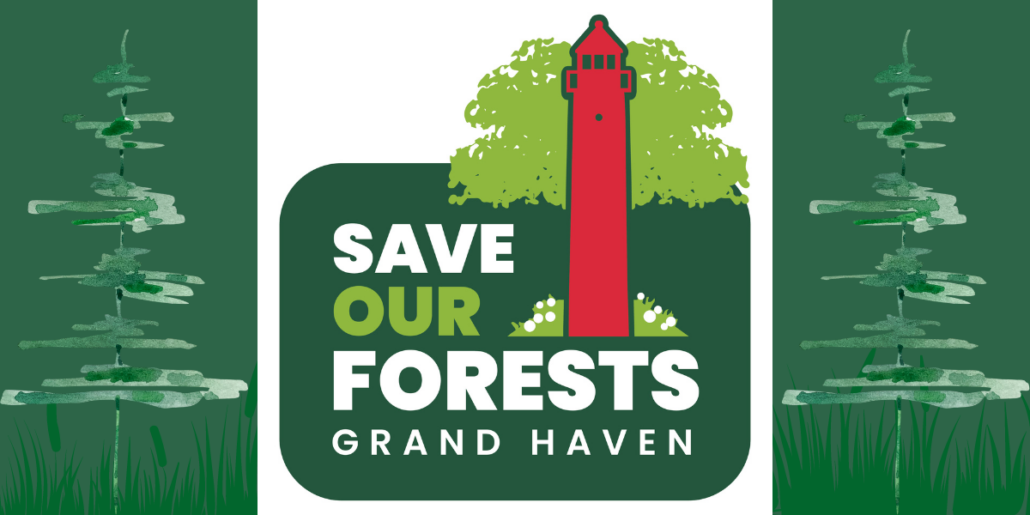By Grace Hasley, Eco-Journalism Intern for West Michigan Environmental Action Council (WMEAC).
This blog was originally published in the Grand Haven Tribune as part of WMEAC’s monthly opinion piece series. We are pleased to share it with our readers in this new format.
The Grand Haven area is well known for its laketown feel and attractive state park, among many other things. The City of Grand Haven is also home to three forests on 200 acres, Mulligans Hollow, Lake Forest Cemetery, and Duncan Woods. These forests provide many recreational and aesthetic values, air quality benefits, and habitats for wildlife. They also help regulate the climate by removing carbon dioxide from the atmosphere and storing it. Duncan Woods is an old growth forest, meaning it has matured over a long period of time without disturbance. With its rare hemlocks and a lush variety of vegetation and trees, Duncan Woods is a precious piece of nature. Grand Haven area residents have been incredibly lucky to have these forests close by to experience nature up close. Unfortunately, this luck could be fleeting.
The three forests are being threatened by diseases which kill trees, including oak wilt, hemlock woolly adelgid (an invasive aphid-like pest) and beech bark disease. These pests could potentially wipe out all of the hemlocks, oaks, and beech trees that currently grace the forest canopy. Fewer trees means more erosion, and loss of habitat for the birds and animals that use the trees as homes and food sources. In addition, native plants have suffered from deer over browsing while invasive species such as garlic mustard and tree of heaven are thriving. Fortunately, a group of concerned people formed in response to these threats; the Forest Management Subcommittee of the City of Grand Haven’s Sustainability and Energy Commission.
It was in 2022 that Jean Madden, Larry Burns, and Jim Mathews connected over their passion for addressing the damage of the local Grand Haven forests. Since then, the group has grown as they developed the “Save Our Forests” campaign. “It quickly became clear that educating residents about the health of our forests and raising money to save them would be our most important considerations,” said Madden.
Subcommittee members have planted 29 native trees and improved the trails in Mulligan’s Hollow. They are also working with the West Michigan Conservation Network, a volunteer group that focuses on invasive species control in seven counties, to treat the trees infected by hemlock woolly adelgid. Also, with funds raised by the Save Our Forests campaign, the City of Grand Haven has purchased a drone for ecological study. A portion of the money raised will go to reforestation according to Madden. “There are currently few, if any, native plants remaining on the forest floor,” she said.”These plants provide critical food and habitat for birds, bees, butterflies, and small mammals. Without them, our forest ecosystem is broken.”
The risks introduced by invasive species, tree pests and insects, and deer over browsing aren’t just random occurrences. Climate change can, and has, thrown off the balance of nature and caused harm like we are seeing in Grand Haven. Invasive species (plants, animals, or organisms) find a new place to live when there are changes in their natural habitat. They’re good at adapting to different environments, making it easy for them to move into different types of ecosystems. But they take over the new habitat and outcompete the existing species for food and a place to live. Not only can climate change increase the risk from invasive species, it can also weaken trees. Rising temperatures disrupt leaf cycles and increase droughts and heat waves, stressing trees. Drought makes trees more prone to insect attacks. Warmer climates also help pests and diseases spread, particularly to heat-weakened trees.
As temperatures rise due to climate change, more deer are thriving through our Michigan winters. Unfortunately, there are now over two million deer in Michigan eating the vegetation, young trees, and underbrush forests. With few natural predators remaining, and a statewide decline in hunting, the mechanisms which historically have kept the deer population in balance are gone. The Forest Management Subcommittee has outlined the harm the large deer populations are causing, for the Grand Haven City Council to determine what will be done to lessen harm to the forests.
The subcommittee is taking all the right actions. It’s inspiring to see concerned individuals take matters into their own hands to make a difference in their community. However, Grand Haven isn’t the only city experiencing these problems in their forests, not by a long shot. I hope to start seeing more groups like this pop up in more communities, not only in Michigan, but all over the world.
You can support the Save Our Forests 3-year plan by spreading the word, donating, and volunteering. To volunteer, email Jean Madden at madbertsfour@gmail.com and contribute to healing the local forests of Grand Haven. To learn more, watch this video created by the group.
To learn more about WMEAC, see www.wmeac.org.


